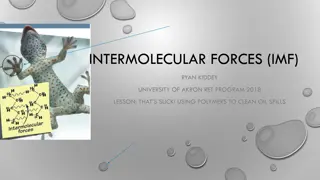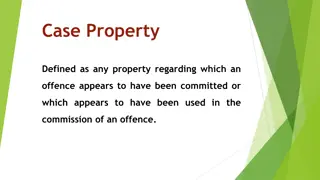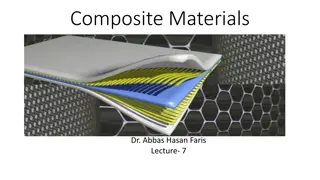Section 5.6 — Intermolecular Forces & Properties
Water's exceptional properties, including polarity and hydrogen bonding, make it essential for life and an excellent solvent. The intermolecular forces in water allow it to function as a vital molecule with distinct characteristics that enable it to interact with other substances like soap. By leveraging these forces, soap can facilitate the mixing of oil and water. Water's role as the universal solvent underscores its significance in various chemical reactions crucial for maintaining life.
Download Presentation

Please find below an Image/Link to download the presentation.
The content on the website is provided AS IS for your information and personal use only. It may not be sold, licensed, or shared on other websites without obtaining consent from the author. Download presentation by click this link. If you encounter any issues during the download, it is possible that the publisher has removed the file from their server.
E N D
Presentation Transcript
Section 5.6Intermolecular Forces & Properties Objectives: Use the intermolecular forces of water to explain how it can function as the important molecule that it is Explain how soap uses intermolecular forces to allow oil and water to mix
Water is Unique! Water may be a common substance on Earth, but its properties are anything but common. Those properties make water essential for life.
Recall: The Structure of Water A molecule of H2O (water) is just 2 hydrogen atoms and 1 oxygen atom linked by covalent bonds. There is, however, a large electronegativity difference between each covalently bonded hydrogen and oxygen.
Since there is a large electronegativity difference, the electron pair is shared unequally. The electrons spend more time around the oxygen atom. This gives the water molecule a positive end and a negative end Therefore, water is polar.
Polarity To repeat, in water, the H ends are + and the oxygen ends are -. This means there are intermolecular forces like attraction and repulsion between water molecules. Recall that the attraction between the H of one molecule and an O of another molecule is called a hydrogen bond.
Properties Because of hydrogen bonding, water is a liquid at room temperature. Similarly-sized nonpolar molecules are gases. Water has a high boiling point and high melting point (compared to other covalent compounds) because of the attraction between water molecules (H bonding). Many of waters physical characteristics are due to the hydrogen bonding that occurs between water molecules.
The Universal Solvent Water is an excellent solvent. The + and charges on the surface of the water molecule attract other polar molecules and pull them into solution. Ionic or polar substances dissolve readily in water. Almost all of the reactions necessary to maintain life take place in aqueous solutions, solutions with water as the solvent.
Oil & Water Water is polar and has + and charges on its surface. Oil (or grease or fatty substances) is non-polar and has no charges. Water cannot pull it into solution. Oil and water don t mix.
Other Properties: Density Water is less dense as a solid than as a liquid. That is why ice floats rather than sinking. Most substance are more dense as solids water is quite unique!
Ice Floats As water cools, its volume decreases (like most substances) because the molecules draw closer together. It get denser. However, at about 4 0C, the water molecules start to move apart due to H bonding and form an organized, stable arrangement called a crystal or crystal lattice. The density of solid water, because the molecules have moved apart somewhat, is therefore LESS than that of liquid water.
Since liquid water expands when it freezes, frozen water pipes can break. The forces involved in the expansion of freezing water are surprisingly great. The processes of freezing and thawing can eventually break up big boulders, contributing to soil formation and erosion on the surface of the Earth.
Aquatic Life The lower density of ice compared to water also means that, in bodies of water, as ice forms, it rises to the surface. These bodies of water have ice at the surface during the winter but rarely freeze all the way through. Surface ice, in fact, insulates the water below from cold air and winds.
Aquatic life is able to survive in the water that is present below the ice layers. Without this unique characteristic of water, entire lakes & ponds would freeze through and all aquatic life would perish.
Surface Tension Surface tension is the resistance of a liquid to spread out. The higher the IMF s in the liquid, the more the molecules stick together. The more the molecules stick together, the less they want to spread out. The higher the IMF s, the higher the surface tension.
Surface Tension in Water Water molecules have strong H bonds to each other. They exhibit high surface tension the surface of water resists spreading to let other molecules through. Water resists having its surface broken .
Cohesion As we saw in surface tension, due to H bonding, water molecules will essentially stick to other water molecules. This property is called cohesion.
Cohesion in Water A single drop of water is composed of an enormous number of water molecules, roughly 2 x 1021. The fact that this large number of molecules can hold together as a single drop is evidence of the high IMF s water molecules have due to H bonding.
Adhesion Water will also stick to surfaces. This is because of the attractive forces between the polar water molecules and the polar molecules in the surface. This property is called adhesion.
How Does Soap Work? To answer this question, we must first look at the structure of soap molecules. Soap molecules have 2 distinct parts a polar head and a non-polar tail Polar head Non-polar tail Soap
The polar portion, since it has + and charges like water, can interact with water. The non-polar portion, having no charges, is able to interact with dirt and grease molecules, which are also nonpolar.
How Soap Works Soap acts as a bridge between water molecules and dirt/grease molecules. One end (the tail ) of soap molecules attach themselves to dirt and grease molecules. The polar heads of soap molecules attach to water molecules. This means that when the water goes down the drain, so does the grease and dirt!
Soap & Surface Tension In addition to acting as a bridge, soap molecules disturb the water molecules ability to form IMF s and stick together. This means that the surface tension of water is lower when soap is added. The lower surface tension allows the water and soap to spread over the dirty dishes.

















































